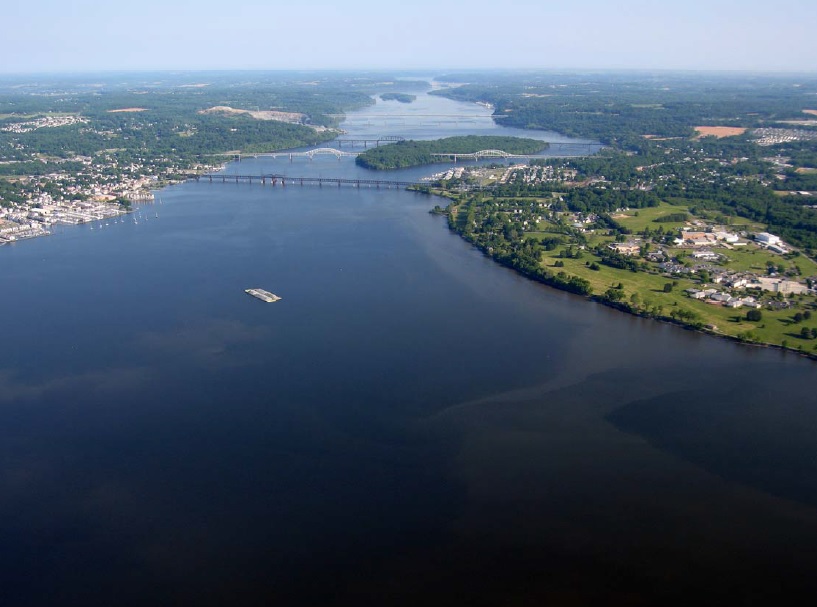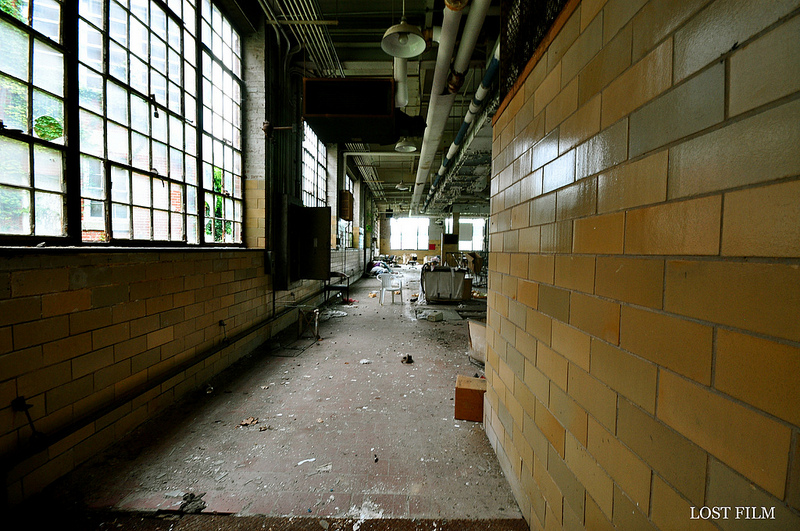Above: Aerial photo of the Lower Susquehanna as it enters the bay. By the Army Corps of Engineers.
By Daniel Menefee
For MarylandReporter.com
The 200 million tons of sediment trapped behind the Conowingo Dam is not a major threat to the health of the Chesapeake Bay, according to a three-year study by the Lower Susquehanna River Watershed Assessment.
“The study concluded that problems at the Conowingo Dam are not as bad as scientists previously thought,” said Alison Prost, Maryland Executive Director of the Chesapeake Bay Foundation. “The dam is one of many sources of pollution throughout the Bay’s drainage area. To clean up the Bay, we must clean up our local streams, creeks and rivers that feed it.”
The study conducted by the Army Corps of Engineers and Maryland Department of the Environment found that 87% of sediment flowing to the Bay through Conowingo from 2008 to 2011 came from Pennsylvania and New York — and only 13% came from the sediment that already rests behind the dam.
The LSRWA study is released as the dam’s operator, Exelon Corp., is on the eve of renewing its license with the Federal Energy Regulatory Commission to operate the Dam through 2060. Exelon helped fund the study.
More pollution from the watershed
”The overwhelming majority of pollution entering the Bay from the Susquehanna River comes not from behind the Conowingo Dam but from the 27,000 square-mile watershed upstream,” Prost said. “That is why we call on New York, Pennsylvania and all the states to implement the Chesapeake Bay Blueprint.”
The study aligns with a cleanup plan mandated by EPA in 2010 – after the Bay Foundation sued the agency to enforce the Clean Water Act. The mandate puts the costs on local governments in the watershed states to reduce the Total Maximum Daily Load of sediment and nutrients that flow to the Bay from local sources. The TMDL places more emphasis on reducing nitrogen and phosphorus than sediment.
“Modeling work completed for this assessment estimated that the sediment loads comprised of sand, silt, and clay particles from scouring of Conowingo Reservoir during storm events, are not the major threat to Chesapeake Bay water quality and aquatic life,” the LSRWA report said. “It is the nutrients associated with the sediment that are the most detrimental factor from scoured loads.”
Conowingo released 42,000 tons of nitrogen, along with 19 million tons of sediment, over a week’s time during Tropical Storm Lee in 2011. The annual nitrogen discharge through the Conowingo without storm events is 71,000 tons.
At odds with Clean Chesapeake Coalition
The findings are at considerable odds with the Clean Chesapeake Coalition, an association of 10 Maryland counties that is challenging the efficacy of the TMDL blueprint — because it ignores the 200 million tons of sediment behind the dam as a significant threat to the health of the Bay.
The coalition advocates dredging the dam as the cheapest way to reduce sediments and nutrients that surge through the dam during storm events. They often cite science from a USGS report that said 40% of the sediment discharge into the Bay from 2002 to 2011 resulted from Tropical Storm Lee alone.
The coalition insists that a multi-state commitment to dredge the dam should be the first priority to increase the dam’s storage capacity — before local governments are forced to pass drastic tax hikes to fund local Watershed Implementation Plans under the mandate.
For instance, tiny Kent County, Maryland’s smallest, would have to fund $60 million to meet its obligation under the mandate. The county’s commitment would amount to nearly 11% of its annual $47 million budget through 2025 and would result in “serious” tax increases in a challenged local economy, said Kent County Commissioner Ron Fithian, who chairs the Clean Chesapeake Coalition.
The Maryland Department of Legislative Services has estimated local governments in Maryland will spend $14.4 billion to comply with the EPA mandate by 2025.
A recent report from the Maryland Public Policy Institute said that 2 million tons of sediment could be removed annually at a cost of $48 million — and would reduce nitrogen at a greater pace than the TMDL blueprint will yield through 2025.
But the just released watershed study says that the benefits of dredging would be “minimal and short-lived and the costs are high.”
“Attempting to dredge the 200 million tons of sediment behind the dam and relocate it safely could waste taxpayer money,” Prost said.
Gov.-elect Larry Hogan Jr. had sided with the Clean Chesapeake Coalition. Timothy Wheeler in the Baltimore Sun quoted Hogan as saying that he had not read the report but questioned its findings, calling the Army Corps a biased source and accusing it of neglecting sediment above the dams for decades.
Dispute over harm from sediment
The coalition disagrees with the conclusion that sediment is not detrimental to aquatic life and blames massive discharges of sediment from the Conowingo for decimating the oyster population in the northern third of the Bay, north of the Bay Bridge, where only 183 bushels were harvested in 2012.
But while the study emphasizes local sources as the greatest threat to the Bay, it does consider the dam’s inability to stop hemorrhages during storm events.
The dam has reached an “end state of sediment storage capacity” and is “no longer trapping sediment and the associated nutrients over the long term,” the study said.
“These additional loads, due to the loss of sediment and associated nutrient trapping capacity in the Conowingo Reservoir, are causing adverse impacts to the Chesapeake Bay ecosystem,” the study said. “These increased loads need to be prevented or offset to restore the health of the Chesapeake Bay ecosystem.”
CBF says Exelon should be held accountable as a source of pollution
“Exelon should be held responsible for its share of the problem,” Prost said. “The buildup behind the Conowingo Dam is one source of pollution, and the dam’s owner should be accountable for reducing that pollution and its impact on the environment.”
The coalition responded late Thursday welcoming the conclusion that the dam had reached its storage capacity – but cautioned against taking dredging off the table by “a tenuous rush to judgment by federal and State agencies and leading environmental organizations.”
The Susquehanna River Basin Commission, Chesapeake Bay Program and the Nature Conservancy also participated in the study.
The coalition also said that the mandate was drafted on incorrect estimates that the dam was trapping 50% of the nutrient-laden sediment that drains into the Susquehanna from New York and Pennsylvania.
“The Bay TMDL will have to be recalibrated to account for this fact,” the coalition said.
Methods and modeling questioned
The coalition also questioned the methods and the modeling used in the study and pointed to three stakeholders that criticized the study for ignoring a USGS prediction that a storm at the magnitude of Hurricane Agnes in 1972 could most likely occur during Exelon’s 46-year re-licensing period.
“The direct impacts of scour of sediment and nutrients from the Project’s Conowingo Pond during the largest storm events expected during the license period have been ignored,” said a joint statement from Stewards of the Lower Susquehanna, Lower Susquehanna Riverkeeper and Waterkeepers Chesapeake to the Federal Energy Regulatory Commission in September. “These size storms were not thoroughly evaluated for their potential impact to the ecosystem of the lower Susquehanna River or Chesapeake Bay. Nor were they evaluated with respect to their potential for causing exceedances of water quality standards.”
Those three organizations are directly involved in the stewardship of the lower Susquehanna and intervened in Exelon’s license proceedings in July of 2013 to demand Exelon take action to mitigate damage from the dam.
The coalition also questioned why LSRWA’s model focused narrowly on the sediment flows from 2008 to 2011.
“Models are only as good as the data put into the models,” said the coalition’s lead counsel, Charles “Chip” MacLeod of Funk & Bolton P.A.
MacLeod also expressed concern that Exelon may have influenced the findings by contributing funds to conduct the study.
He quoted a letter from DNR Secretary John Griffin to then Senate Minority Leader E. J. Pipkin in 2013, claiming that Exelon had “made a critical financial contribution to DNR to fill a Corps of Engineers’ funding gap.”








tree hugging liberals care more about the bay then they do about people. makes me sick. I live near the south river… 30+ yrs ago this river was filthy dirty…. id bet money its just as filthy today… despite who knows how many millions have been taken from us to supposedly clean it up..
environmentalism is another way liberals pick our pockets and take our money. it’s getting old… people are getting tired of government taking our money for stupid stuff. And we have less and less to live on. this is part of the change people voted for a few weeks ago in MD…
Gee, imagine if the point of this whole Conowingo smokescreen was to divert Bay cleanup funds to deflect or limit good ol’ Exelon’s liability and expense for dredging?
“The LSRWA study is released as the dam’s operator, Exelon Corp., is on the eve of renewing its license with the Federal Energy Regulatory Commission to operate the Dam through 2060. Exelon helped fund the study.”
“Timothy Wheeler in the Baltimore Sun quoted Hogan as saying that he had not read the report but questioned its findings, calling the Army Corps a biased source and accusing it of neglecting sediment above the dams for decades.”
sigh…..